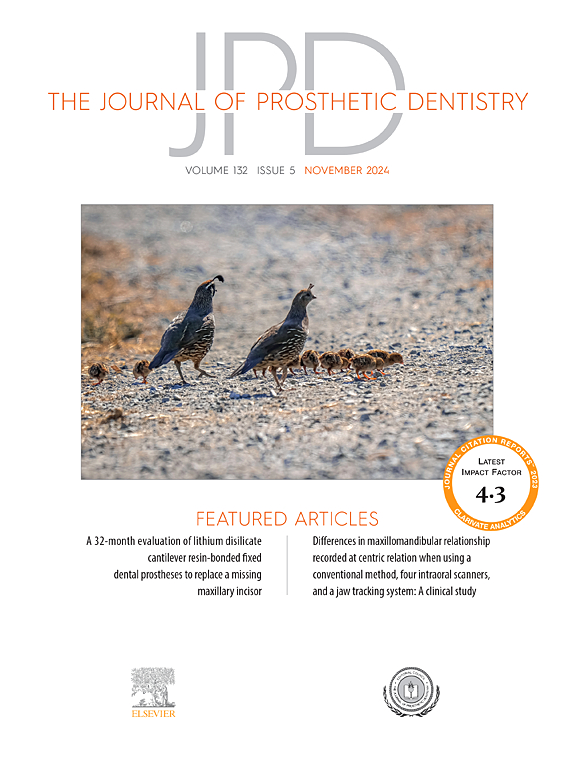Effectiveness and one-year whiteness stability of different in-office bleaching agents and alternative protocols
IF 4.3
2区 医学
Q1 DENTISTRY, ORAL SURGERY & MEDICINE
引用次数: 0
Abstract
Statement of problem
In-office bleaching has been widely researched. However, few studies have evaluated alternative protocols for this procedure. Moreover, information on the long-term stability of in-office whitening is limited.
Purpose
The purpose of this in vitro study was to evaluate the effectiveness and 1-year stability of in-office bleaching with 35% hydrogen peroxide (35%HP) and 37% carbamide peroxide (37%CP) using traditional and alternative protocols.
Material and methods
Forty human third molars were stained with tea and allocated to groups (n=10). Traditional protocols consisted of 3 applications of 35%HP for 15 minutes and 1 application of 37%CP for 45 minutes. Alternative protocols consisted of 1 application of 35%HP for 45 minutes and 3 applications of 37%CP for 45 minutes. Protocols were applied for 3 weeks. CIELab color coordinates were measured at baseline and weekly during treatment and at 1-week, 6-month, and 1-year follow-ups. Effectiveness and stability of the bleaching treatments were interpreted using 50:50% perceptibility and acceptability thresholds. CIELab, chroma, hue angle, and whiteness index were analyzed using the Wilcoxon signed-rank test (α=.05).
Results
All protocols showed improvement in bleaching after the first week (P≤.005). All bleaching procedures presented excellent whitening outcomes. Alternative protocols showed a larger rebound effect after 1 year, indicating less stability. For the whiteness index, no differences between the completion of the treatments and 1-year follow-up was found for the bleaching treatments and protocols (P>.05), except for the 37%CP alternative protocol (P=.005).
Conclusions
All tested protocols presented excellent effectiveness in bleaching. Traditional protocols exhibited a greater whiteness stability, while the alternative protocols showed a greater rebound effect after 1 year.
不同诊室漂白剂和替代方案的效果和一年白度稳定性。
问题陈述:诊室漂白已被广泛研究。然而,很少有研究对这一程序的替代方案进行评估。目的:这项体外研究的目的是评估使用35%过氧化氢(35%HP)和37%过氧化碳酰胺(37%CP)的传统和替代方案进行诊室漂白的有效性和1年的稳定性:用茶水对 40 颗人类第三磨牙进行染色,并将其分配到各组(n=10)。传统方案包括使用 35%HP 3 次,每次 15 分钟;使用 37%CP 1 次,每次 45 分钟。替代方案包括 1 次使用 35%HP 45 分钟,3 次使用 37%CP 45 分钟。这些方案持续使用 3 周。在基线、治疗期间的每周以及 1 周、6 个月和 1 年的随访中测量 CIELab 色度坐标。漂白治疗的有效性和稳定性采用 50:50% 的可感知性和可接受性阈值进行解释。采用Wilcoxon符号秩检验(α=.05)对CIELab、色度、色调角和白度指数进行分析:所有漂白方案在第一周后都有改善(P≤.005)。所有漂白程序都取得了极佳的美白效果。替代方案在一年后显示出更大的反弹效果,表明稳定性较差。在白度指数方面,除37%CP替代方案(P=.005)外,其他漂白疗法和方案在治疗结束和1年随访期间均无差异(P>.05):结论:所有测试方案都具有出色的漂白效果。传统方案显示出更高的白度稳定性,而替代方案在一年后显示出更高的反弹效果。
本文章由计算机程序翻译,如有差异,请以英文原文为准。
求助全文
约1分钟内获得全文
求助全文
来源期刊

Journal of Prosthetic Dentistry
医学-牙科与口腔外科
CiteScore
7.00
自引率
13.00%
发文量
599
审稿时长
69 days
期刊介绍:
The Journal of Prosthetic Dentistry is the leading professional journal devoted exclusively to prosthetic and restorative dentistry. The Journal is the official publication for 24 leading U.S. international prosthodontic organizations. The monthly publication features timely, original peer-reviewed articles on the newest techniques, dental materials, and research findings. The Journal serves prosthodontists and dentists in advanced practice, and features color photos that illustrate many step-by-step procedures. The Journal of Prosthetic Dentistry is included in Index Medicus and CINAHL.
 求助内容:
求助内容: 应助结果提醒方式:
应助结果提醒方式:


